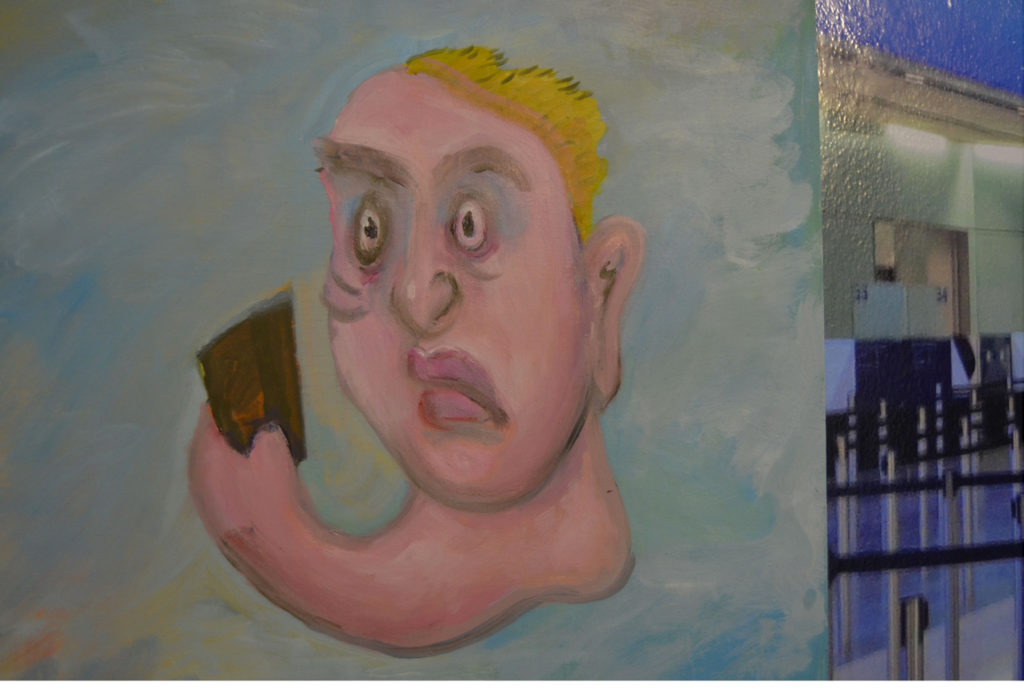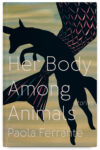
Art by Jenifer Evans (now Jasen Verefin)
This essay first appeared in the Full Stop Quarterly, Issue #7. To help us continue to pay our writers, please consider subscribing.
I live in a tall, wooden, barn-shaped house on top of one of the many impromptu hills of East Oakland. The house is old, I’ve heard from the late nineteenth century, and above most neighboring wind cover, so it sways seemingly at the slightest maritime breeze. I’ll be reading in bed or on the couch and I’ll feel my book ever-so-slightly shaking, be eating and feel my fork, my spoon, vanilla yogurt and granola-laden, imperceptibly quivering. The house rocks when people bumble through it, when a door opens, when my roommates or my partner and I are having even just placid couple sex. On top of that, I also have like generally shaky hands (always have) so it’s often hard to tell what’s internal and what’s external jitter.
Either way, the jitter is real and ever-present and ubiquitously alarming.
One of my top google results, if not the top, which my phone pitifully spits out at me every time, mercifully if a tad disgustedly, like an embarrassed relative, the reluctant algorithm, ashamed to finish my sentence, is “bay area earthquakes today.” Or “earthquakes bay area.” Or “Oakland earthquake right now.” Or, most pathetically, “Was that just an earthquake?” Since I’ve been living here starting in 2014 the answer has been unanimously no, or a tepid yeah but only twice, once for a 3.1 or 3.2 that I slept through and another of similar strength that my partner, an Oakland resident for over a decade, described as “a jolt, but basically nothing.” I, shaky hands to the wheel, found myself petrified and googling uncontrollably for weeks afterward. Once a week at a minimum I’ll feel the house quiver and immediately reach for my phone, only to find there’s hundreds of small quakes perforating the valleys and ranges of California on any given day but not one happening right now under my feet, not the one I’m waiting for, not the one I’m thinking of.
My neighborhood, Fruitvale, in its palm-studded seesawing lassitude, feels a lot more like LA than the rest of Oakland. It’s also less likely to liquefy than the last place I lived in West Oakland. Regardless, in LA, in Oakland, in Fresno, in California, in effervescent Cali, you are always aware of how your house quakes, how your home, your domicile, your refuge might at any moment collapse. My friend Stephanie has told me where she will and won’t stand because of this fear. My friend Meg, trained in neighborhood earthquake safety and readiness, has told my partner she always keeps a pair of hard-toed shoes under her bed in case she is forced to bolt awake and commence the fabled “scramble through rubble.” According to geologic maps, my house is apparently, unbelievably, blessedly, on the only “solid bedrock” in the neighborhood. Like, literally, our house and our neighbor’s house and maybe the next one down. It’s not in “the hills” per se, but between the freeways, and just happens to be on a hill, this hill, here, which is incredibly, indisputably lucky. My roommates and I have concluded it must’ve survived multiple earthquakes, big ones, the big ones, 1910 and 1989, and I count that as a sort of consecration of its sturdiness. Still—it’s old, it’s oddly shaped, the walls and floors aren’t perfectly level, and it’s three wobbly, hardly trustworthy stories tall.
Elsewhere around us, the ground is less stable but still bedrock, and then sweeping down toward the bay becomes sedimentary fill, marked on geologic maps in deep, velvety crimson as the “Liquefaction Zone.” Part of California, part of the florid bright blue and pinkening dream, is its terminal proximity to catastrophe, its ever-lessening distance to—strange figure enters, screen goes dark—the end. The massive Pacific, the treacherous heat, the capricious hillsides, the glowing smog, the fault lines balancing tensely in fifth position en avant—these are all catastrophes waiting to happen, these are the driving forces, the stigmas of California’s relentless fluttering energy, the terror behind the dumpster behind the diner in Mulholland Drive, animating the last gasps of a continent we have all but abandoned, Icarus-style, why not, driven like flies to the warped heat of the Hollywood sign, the Golden Gate Bridge, morbid and romantic and fanatical in our pursuit of whatever unprecedented climax is on the geologic and atmospheric cusp of culmination here in—breathe it in—ah, yes—oh, no—the Golden State.
* * *
I’ve been preoccupied with trying to write about climate change and art for a while now. My basic premise (although I could hardly call it mine, not at all) is that climate change is not only radically changing the world and its systems, but also demanding radically new methods and impulses. It’s hard to know how to deal with climate change, but it’s easy to know we need a new way to think about. Plenty of artists and writers are delving into this currently, potently. I’m thinking of indigenous communities and their persistent imaginative activisms; I’m thinking of a number of the ecopoetic anthologies and readers that have come out over the past few years; I’m thinking of New Materialist anthropologies and a new interest in hybrid, multispecies sciences; I’m thinking of climate writers Bill McKibben and Naomi Klein and their movements explicating capitalism and climate change; I’m thinking of the president of the Maldives holding a cabinet meeting underwater.
A shifting world calls for shifting mimeses—a simple enough notion, right? If a river changes course, satellite images over time will show that. So will area photographs. We might, however, still write or paint it symbolically in the same way we used to, as metaphor and metonym can to a certain extent withstand the test of time. Just because it now flows past this cottonwood stand or beneath this bridge, a mile in one direction or another, it wouldn’t utterly dissolve the river’s symbolic meaning or import, as it still relates and corresponds to a reality we acknowledge. But if the river stops flowing entirely. Or, worse, calamitous, if the river suddenly floods to the point of overflow, to the cusp of disappearance. And it’s our fault. Why are we still painting an idyllic river?
A thought I’ve had, and one I’m starting more and more to believe, is that perhaps my unrelenting fear of earthquakes is a proxy for my fear of the less distinct or conceivable rumblings of climate change. We are entering (scratch that, have entered) a geologic and climactic era of just such “big ones,” defined in equal parts by that very lack of precedent and improbability. The fear, the fixation ferments between the certainty of the crisis and the inconceivability of the calamities. Baked into it is a problem of representation. The issue is not only with witness—“has it happened yet?”—but also with believability—“do I believe it can happen?” These are both questions for science, but just as fundamentally are questions of art.
* * *
Two recent, vital books I’ve come across in my somewhat uneasy explorations—Amitav Ghosh’s The Great Derangement and Andrew Durbin’s MacArthur Park—both have to do with these questions of believability and witness while framing narratives around, inside, because of climate change. Fittingly, one, Ghosh’s book, is a set of lectures largely about how the novel and fiction have failed to appropriately represent the scope and scale of climate change, while the other, Durbin’s, is a novel anxiously, windingly trying to deal with the personal, social, and narrative fallout of life after climate disaster. These are not necessarily books in conflict, however, but provide some potent answers when read in tandem.
At the heart of both books is a particular climate catastrophe. For Ghosh, the world-renowned Indian novelist whose books often involve the natural and supernatural, it’s a sudden tornado in North Delhi. This kind of twister was unheard of in the region—“So unfamiliar was this phenomenon that the papers literally did not know what to call it: at a loss for words they resorted to ‘cyclone’ and ‘funnel-shaped whirlwind.’” Unrelated to climate change as far as Ghosh can inter, the Delhi tornado does however share its fundamental unfamiliarity with the climactic phenomena we have come to recognize as typifying the “Anthropocene” or “Capitalocene” or which-other-ever you prefer. And it’s the disaster’s very lack of precedent, its improbability that renders it to Ghosh, after repeated attempts to fit it into any number of his novels, an unworkable contrivance. “To introduce such happenings in a novel,” Ghosh protests wryly, “is to risk banishment to the humbler dwellings . . . the outhouses . . . called ‘fantasy,’ ‘horror,’ and ‘science fiction.’”
Distilling this formative disillusion of trying to write something so real it seems basically just not believable—climate catastrophe—in his “realist” novels, Ghosh looks around for other examples of literary novels that do this very thing. And yet, scanning Pulitzer and bestseller lists, best-of awards and review supplements, he finds no such model of any kind. Ghosh admits a certain literary, prestigious, bestseller, big press bias in his probings, but that’s exactly where he’s looking (and should be looking) to find a noteworthy model for a fiction that effectively deals with or at least reflects climate change.
Baffled, The Great Derangement in turn becomes a scrupulous examination of the literary novel’s growth and development around the world and the larger politics of storytelling forms throughout the ages. Early on, Ghosh traces “the realist novel’s ‘mimetic ambition’” alongside prevailing European imperial and Enlightenment ambitions of the 18th century, arguing that the realist novel is a “vessel for the containment of the same kind of experience” that Cartesian dualism and Enlightenment scientific realism announces for the “modern” man. “A vessel,” really, of political convenience and mimetic expedience, the realist novel offers “the kind of narrative pleasure compatible with the new regularity of bourgeois life.” The world the novel in its nascence presents—the world of Austen and Flaubert, of “calm passions” and anthropocentric ascendancy, of “[scientific gradualism’s] uniformitarian expectations” and private discontinuities from the earth at large—a world indeed of climactic stability—is the world Enlightenment thinking aims to codify.
There is, however, an even greater crux to Ghosh’s argument. In his eyes the complicity (and power) of the novel doesn’t stop in its infancy, but only grows larger as the intertwined project(s) of colonialism, industrialism, capitalism, and realism grow(s). Ghosh forcefully points to later novelists and literary realists like John Updike (who else, right?) and others as continuing to “midwife . . . the expressions and concealments of the cultural matrix that brought them into being.” The novel essentially becomes an entrenched argument, a cultural notarization, for the kind of unquestionably stable and endlessly growing world imperialism and capitalism, the neoliberal Hydra, projects. Its patented cocktail of interiority, individuality, and anthropocentrism gradually become an anesthetic of the Huxley, Brave New World, variety. Go figure. As Naomi Klein, Bill McKibben, and others climate writers have pointed out, capitalism, colonialism, and the tremendous economic and cultural wealth they produced (for a few nation-states) were executed only through a rapid and disturbing rise in carbon emissions beginning in the mid to late-nineteenth century. Time thus dilated, to use McKibben’s phrase; there is no “modernity” without excessive emissions. Emissions, capital, culture—literature, mimesis, the novel—Ghosh recognizes their intertwined histories in a sort of gut punch to the modern promise of Western Humanities:
I have come to recognize that challenges that climate change poses for the contemporary writer . . . derive ultimately from the grid of literary forms and conventions that came to shape the narrative imagination in precisely that period when the accumulation of carbon in the atmosphere was rewriting the destiny of the earth.
There is something deeply disturbing in what Ghosh is revealing here, a cultural matrix and entire system of seeing and representing our world (one, I should add, that we still lean on) that is utterly complicit in ecologically and colonially exploitative agendas. Surprisingly, though, it’s not outrage as much exasperation that punctuates The Great Derangement. Toward the book’s end, he wonders aloud if future generations, looking at our cultural footprints, our stories and worldviews (and so our novels), not having hardly written about or barely even heeded the very thing presently threatening all life on earth—climate change—won’t see us as deeply deranged, won’t call this period “The Great Derangement”? As a novelist, Ghosh is clearly bothered and openly conflicted about what he sees as the novel’s complicity, its inability to deal with climate change—as opposed to race, class, war—in any truly impactful way. The novel, in short, in say less than 140 characters, is #emissioncomplicit and so are we.
* * *
It’s fire season, the ground is charred (or ready for charring), and I’ve just returned from a month abroad. I’ve been in the mossy, wooded archipelago of southern Finland, blueberry picking, swimming to islands—and flying in low over the California hills and valleys is truly shocking. It’s another world entirely, one I’m perhaps used to but not quite prepared for. Even when we get over the hills and into the bay, wheels pulling down, I still can’t hardly recognize where I am. It’s a shade of brown, a drab callous canvas I haven’t seen in over a month. This is where I live? I know there have been a number of fires since I’ve been away, increasingly turbulent, spread by thin winds across the state, and otherwise it’s been hot, dry, indelibly sunny. Still, it’s hard to square this with my imagination, with the reality I imagine myself living in, the dreamy, swaying haven of bay area life.
It’s not that I’m not used to it, again—I grew up in the west and am familiar with the comings and goings of fire season. Summer to me has always been a bit harsh, from torrid June flood days to parched Julys, a time to squirrel away from hundred-degree days, and I’ve lived with ambient Augusts of wildfire smoke wafting through windows, ash snowing on my head. Thing is, there used to be, or, rather, I used to be able to imagine, these imaginative equivalences, these seasonal frameworks for an operational world. August was August, July, July, maybe a touch of June lingering. But these frames don’t seem to make as much sense as they used to, these months, what are those?
Recently, in August 2017, the NY Times published the final draft report of the National Climate Assessment, a federally mandated climate report that comes out every four years, leaked to the paper for fear the Trump administration (gulp) would either drastically alter or conceal its findings. The report shows, atop even more startling proof of a changing climate, a disturbing new ability of scientists to pinpoint with increasing certainty the underlying (read: human) causes of any particular climate event. The Times reporter, Lisa Friedman, summarizes, “Among the more significant of the study’s findings is that it is possible to attribute some extreme weather to climate change. The field known as ‘attribution science’ has advanced rapidly in response to increasing risks from climate change.” The report goes on to stress two other points that stick with me, almost like lines of a poem:
“Extremes are projected to increase more than averages.”
“The world’s oceans have absorbed about 93% of the excess heat caused by greenhouse gas emissions since the mid-twentieth century, making them warmer and altering global and regional climate feedbacks.”
What do these three factors implicitly point to or triangulate that so disturbs me? Perhaps between “attribution science’s” language of equivocation and likelihood, an increase less in normalcies than in extremes, and the majority of excess heat entering into relatively unseen feedback loops at the watery margins of humanity, it seems a regime of human-caused climate change doesn’t so much compose a “new reality” as a radically distorted one, a punctured and warped and increasingly unreliable one. I guess my rushed follow-up question would be: How much does such a destabilized reality constitute a “reality” at all?
Indeed, it seems to me as if we’re on a continual imaginative slope that gets ever more precipitous with each passing season, with every reminder of increasing climactic turbulence. There seems to be less living in this season, less “nice summers” or “tough winters” (cue nodding neighbor, chatty family member on the phone), because this season, whatever its particular storm or tribulation, whatever climactic harshness puts scare quotes around it as “different” or “disrupted,” projects us into the next season and the next, into a mounting reality of “seasons” with quotes around them, of future calamity and continual, proverbial, especially imaginative loss.
McKibben puts his finger on this when he asserts the best thing we can do is simply, hugely scale back our expectations for what livability looks like on a planet “Eaarth,” an earth painfully but irrevocably changed. It may look like earth, it may feel like our life, but there is something distinctly off at the rising tidal shore where the impending future meets this porous, mercurial present. I believe Ghosh is most right in this regard. Realism is a project in bad need of a renovation.
* * *
This sense of a shifting present impacted by climate crisis and its confounding feedbacks, hard to pinpoint yet dangerously proximate, is central to Andrew Durbin’s debut novel, MacArthur Park. The novel follows Nick, a young, gay art writer and poet from New York, through the process of trying to write this nebulous book of his, the one we’re reading, a book he uncertainly, sheepishly resorts to describing as “about the weather.” MacArthur Park begins in the blackout dark of Manhattan during Hurricane Sandy, in the “full dark, a dark you could brag about,” where Nick, a typically poor post-collegiate Brooklynite and aspiring writer, is housesitting for a wealthier art collector and boss of his. This is where the novel starts because this where Nick’s “novel” starts, his sense of reality not so much punctured as subsumed by the overwhelming speculative and imaginative force of the disaster:
Having lost nothing, no one, I nevertheless felt I’d already lost a world. I kept a notebook of writings about storms that I would later shape into an essay, one of the first pieces that I would publish as I struggled to become a writer, though at that moment, it felt entirely shapeless—and, in that way, this writing resembled me.
Loss, disaster, a shaking eaarth of shapeless alarm. The disruptive force of Sandy, to “not only its real geography but the geography of the imagination,” takes its toll on the narrator’s ability to find a coherent narrative, the writer’s ability to write an intelligibly singular book. The way Nick speaks of being rendered “shapeless” by this unfamiliar disaster utterly rhymes, to the point that it sounds like something Durbin himself could’ve written, with how Ghosh speaks in the aftermath of his “funnel-shaped whirlwind:”
What had happened at that moment was strangely like a species of visual contact, of beholding and being beheld. And in that instant of contact something was planted deep in my mind, something irreducibly mysterious, something quite apart from the danger that I had been in and the destruction that I had witnessed; something that was not a property of the thing itself but of the manner in which it intersected with my life.
A deep, mysterious, shapeless catastrophe; an intersection of the known and the unknown, the witnessed and the not-quite-believed. Nick’s intersection with the shapeless beholding Sandy plants deeply within, makes MacArthur Park a book of digressions and lacunae, of restless identifications and deep uncertainties, a book his MFA workshop—assuming there was one—would hardly approve. Following him drunkenly to gay clubs, picking up where blackouts left off at queer dance parties, from New York, city and upstate, to LA, to Europe, on hardly fruitful art writing assignments to anxiety-riddled readings and gossip-laden meet-ups and exhibitions, we ramble through hypothetical “research” wormholes about artists and cults, into and out of brief cruising affairs as well as a rather tenuous long-term relationship, learning extensively about the artists Nick becomes obsessed with or is tasked with covering—the Tom of Finland Foundation, for example, or a controversial, somewhat cultish artist residency and farm he visits upstate. Nick’s boyfriend for the bulk of the novel, Simon, introduces Nick to the novel’s other main characters, Zachary and Julia, who, together, produce the sort of turbulent social “weather” Nick, post-Sandy, is so riddled by.
From page to page, section to section, Durbin’s novel slides around on formal and perspectival ice, from highly internalized thought monologues to off-the-cuff artist profiles descending into social histories and critical takes, excerpts of journal entries and first to third-person narrator shifts. Narrative is less about scene than it is frame. And Durbin, a poet and art writer (and now, voila, a novelist) himself like Nick, takes advantage of the capacious frame a “novel” provides to gather the “nebulous, unfocused” strands of his thinking into something portraying the shifting dispersal of elements and characters, of anxieties and desires issuing from the eye of a post-superstorm world. Beyond any poetry manuscript or art writing or essay, all of which are part of MacArthur Park, a novel is, to twist Woolf’s figuration, a book of one’s own. In fact, the history of poet’s novels, in which I’d deservedly file MacArthur Park, is very much one of renting, nay, housesitting, the form to think out loud—think recently of Eileen Myles’, Inferno, in which adrift, capital-P Poet is again afforded a vital, performative spell as Housesitter—to gather and group expansively, obliquely, without commitment to a singular logic or purpose or form. Nick needs “the novel” as much as Durbin does; it’s the only way he has to integrate this mass of experience—disaster, desire, friendship, art—into a singular body, his body, his book:
My poems, essays, and short fictions, the things that I hadn’t published but was grouping together in a single “Untitled book thing” folder on my computer, were about disaster, hurricanes, and storms. In these texts my sense of weather had enlarged to include the turbulent atmosphere of human events, the ways in which we face or avoid crisis, the ways we skid toward crisis, helplessly, together and alone. Crisis, the mom of us all. I didn’t know if it was a book or not, but maybe now it was one, finally.
What I so profoundly appreciate about MacArthur Park is how straightforward it is with this hopeless “book thing”—in the face of climate change, in the face of apprehending what exactly climate change changes—and how resolved Durbin, or Nick, is in his pursuit of making sense of that hopelessness. The book “thing” is nearly three hundred-pages, and yet really it could just be a twenty-page essay—literally, the twenty-page untitled prologue about Nick during Hurricane Sandy that acts as the book’s catalyst. The rest of the novel, which is indeed the whole of it, the oceanic 93% of it flowing into unseen feedback loops from the watery margins, acts instead more like research for the underlying enervations and misgivings a climate disaster of that proportion (quite literally) rains down upon Nick. His reality has been disturbed, and it doesn’t go back. Though the dance parties and bars are different and the characters come and go, the novel ends up at the same perplexing terminuses and tenuous conclusions repeatedly:
Over a whiskey I resolved to make something of it, a writing that would attempt to describe—and account for—the state of things, the state being disaster, that would in turn look like a writing that would become a book, one that organizes the anxiety of that extremity into a fiction or an essay or a poetry or a thing that reads like all three. Winds, oceans, landmasses, cracks, fissures, floods, stress points, breakage. Wigs of weather we wear to convince ourselves that we are something that we are not; springs like summer, falls like summer, winters like summer—the planet of summer, and its eternal present.
After disaster, there is only disaster. It is a familiar and unrecognizable present. And whether we recognize it or not, whether we read it or write it or not, we are living the climate crisis. As Ghosh writes, “[The literary novel’s] failures will have to be counted as an aspect of the broader imaginative and cultural failure that lies at the heart of the climate crisis . . . For let us make no mistake: The climate crisis is also a crisis of culture, and thus of the imagination.” MacArthur Park, to me, hazards its way out to the imaginative limits of that culture, a culture of the novel and its attendant “realisms,” its machinations of precedent and probability, belief and witness. In a book that anxiously reprises itself in a kind of endlessly refining ars poetica, the best way to put it is the way Nick, the way Durbin himself does:
The book struggled, self-consciously, with narrative: how to put the things that made up my life, but also the lives of others, into the form of a story. That was all I had. When someone asked me what it was about, I stuck to my line: “The weather.” Which weather? It had ceased to mean the state of the atmosphere, the wind, visibility, heat, the chance of rain, and had become instead something far larger, a broader system, one that encompassed our politics, or the politics that had come to encompass us, the politics that were to come.
Jacob Kahn is a poet and bookseller at Wolfman Books in Oakland, CA. He is the Reviews Editor for Wolfman New Life Quarterly and the author of the book A Circuit of Yields (2014), as well as a 2018 Frontier Fellow from Epicenter in Green River, UT. Other work can be found in Elderly, Open House, and the forthcoming Emerald Tablet II from Bootstrap Press.
This post may contain affiliate links.







